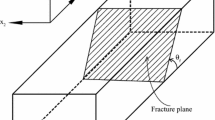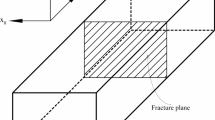Abstract
When fracture toughness testing is carried out over the ductile to brittle transition temperature region cleavage instability may be observed at the initiation of cracking or after some prior ductile crack growth. The amount of precleavage ductile crack growth increases with increasing temperature. At the lower test temperatures, it is possible to assume that all tests will result in cleavage instability. However, as the test temperature increases, at some limiting temperature, the failure mode during the final instability changes from cleavage to ductile. These two different types of behaviour can be accommodated in a statistical analysis which is based on the method of competing risks. A statistical approach is presented for the analysis of data by competing risks and a procedure is given for the estimation of the probability of cleavage failure.
Similar content being viewed by others
References
J.F. Knott, Fundamentals of Fracture Mechanics, Butterworths, London (1973).
P.E.J. Flewitt, G.H. Williams and M.B. Wright, Nuclear Engineering 31 No. 5 (1992) 383–391.
I. Milne, R.A. Ainsworth, A.R. Dowling and A.T. Stewart, Assessment of the integrity of structures containing defects, CEGB Report R/H/R6 Rev.3 (1986).
A.H. Cottrell, ‘The Griffith Crack’, Proceedings of the Griffith Centenary Meeting, The Institute of Metals (1993).
M.S. Kamath and M.F. Gittos, The Welding Institute Research Bulletin 114–122, April 1979.
J.R. Rice and M.A. Johnson, in Inelastic Behaviour of Solids M.F. Kanninen, W.G. Adler, A.R. Rosenfield and R.I. Jaffee (eds.), Mc Graw-Hill, New York (1970) 641–672.
R.M. McMeeking, Journal of the Mechanics and Physics of Solids 25 (1977) 357–358.
D.M. Tracey, Journal of Engineering Materials and Technology, Transactions ASME Series H 98 (1976) 146–151.
J.P. Rice and D.M. Tracey, Journal of the Mechanics and Physics of Solids 17 (1969) 201–217.
R.O. Ritchie and Thompson, Metallurgical Transactions A 16 (1985) 233–248.
R.O. Ritchie, J.F. Knott and J.R. Rice, Journal of the Mechanics and Physics of Solids 21 (1973) 395–410.
ESIS P2-92 (1992) ESIS Procedure for Determining the Fracture Behaviour of Materials, January 1992.
United Kingdom Atomic Energy Authority, ‘An Assessment of the Integrity of PWR Pressure Vessels’, Addendum to the Second Report of the Study Group, Her Majesty's Stationary Office, April 1987.
J.F. Lawless, Statistical Models for Lifetime Data, John Wiley and Sons (1982).
Crowder, Kimber, Smith and Sweeting, Statistical Analysis of Reliability Data, Chapman and Hall (1991).
K. Takahasi, Annales de l'Institut Statist. Math. 17 (1965) 257–260.
D.G. Clayton, Biometrica 65 (1978) 141–151.
M.J. Crowder, Journal Royal Statistical Society B 47 (1985) 447–452.
P. Hougaard, Biometrika 73 (1986) 387–396.
J.M. Crowder, Journal of the Royal Society B 51 (1989) 93–107.
Author information
Authors and Affiliations
Rights and permissions
About this article
Cite this article
Moskovic, R., Crowder, M.J. Competing risks models for fracture in the ductile to brittle transition temperature region. Int J Fract 73, 201–212 (1995). https://doi.org/10.1007/BF00037643
Received:
Accepted:
Issue Date:
DOI: https://doi.org/10.1007/BF00037643




